
|
A Celebration of Beetles: A Ramble All Over the Place by Richard L. Howey, Wyoming, USA |
Sometime back in the last century (Hey, that was only 13 years ago), I got obsessed with beetles (with a few true bugs, mantids, and leaf and stick insects thrown in). A lot of insects which we call bugs aren’t really bugs. There are just 2 orders of true bugs–Hemiptera and Homoptera and, along the way, I’ll show you an example or two of true bugs. On the Internet, I happened across a husband-and-wife company that had a splendid variety of beetles for exceptionally reasonable prices. I’m not going to tell you their site, for they have gone out of business, even though portions of the site are still on the Internet (once on the Internet forever on the Internet–a kind of pseudo-immortality). And if they were still in business, I probably still wouldn’t give you their site, because then you’d go in and buy all their good stuff before I could get to it. I’m mean that way.
For 3 or 4 years, I was able to acquire some splendid specimens and now I want to share images of some of them with you and, along the way, either in an addendum or in a subsequent article, indulge in a bit of computer fun by using my graphics program to do some playful modifications of some of these images.
WARNING: I am an outrageous enthusiast for many of these creatures and I will likely ramble on and on about my favorites.
I have plastic compartmentalized boxes in which I store some of the small specimens and duplicates. I refer to these as my jewel boxes because, to my mind, some of these beasties outshine many of the sorts of ornamentation which we devise to advertise ourselves. Those that do equal my six-legged friends are often copied from nature and employ precious metals and gems.
A Note On Storage:
1) Here is an image of the kind of plastic boxes I use.

I buy packets from a craft store of small wooden sticks that look like miniature tongue depressors. I tape one inside the top of each box and then, using a disposable pipet, coat it with cedarwood oil which it readily absorbs. Every 2 months or so, new cedarwood oil should be added.
This is a precaution against other insects that like to invade and munch on your specimens and they can do a considerable amount of damage in a short time. The cedarwood oil acts as a repellent.
1) For special and/or larger specimens, I use Riker mounts.
Before closing these, I add a crystal or two of thymol which is also an effective repellent. It has a somewhat unpleasant odor and one should be careful not to inhale the fumes or handle the crystals with bare hands. It is somewhat less obnoxious than paradichlorobenzene (moth ball crystals).
Let’s begin with a couple of specimens that even non-beetle lovers will find non-threatening. These are a male and female of the genus Phaneus which are rhinoceros beetles. These are exquisite little creatures which look like they were carved out of jade.
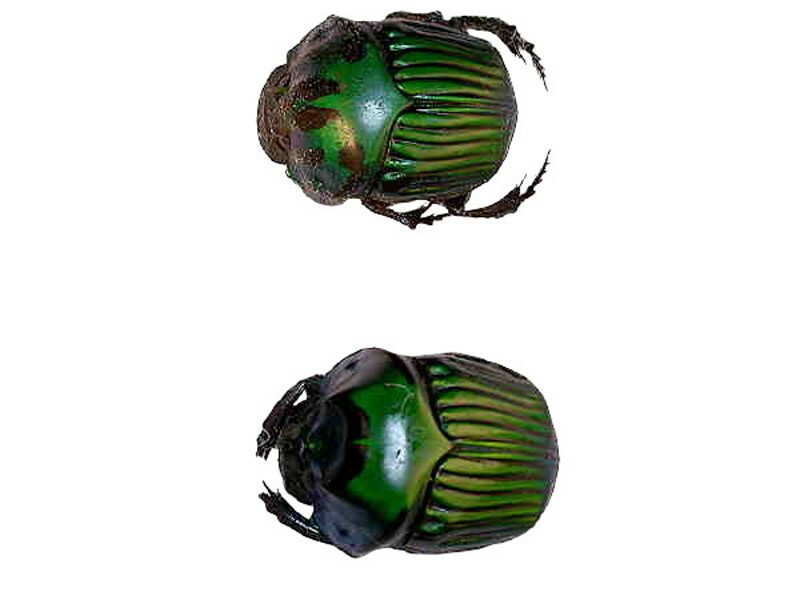
Notice the deep rich color and the remarkable striations on the elytra (wing cases). If one could obtain the right sort of jade and find a skilled craftsman, one could start an entire line of jewelry beginning with earrings, then branch out into brooches and pendants.
Next, let’s take a look at a weevil. Weevils are recognizable by an elongated “snout” at the end of which one finds the eyes and the antennae. Weevils are often regarded as pests but, Eupholus is, as you shall see, quite an elegant chap.

Here there is a striking contrast between the rich blue dominating most of the body and the accenting black stripes. Notice that even the legs are blue.
When we turn it over to examine the ventral side, we discover a number of wonderful features. The feet have brown pads composed of coarse hairs which helps the weevil cling to whatever it may be climbing. Here are 2 view of the foot pad.


If you start examining beetles closely, one of the things, you will quickly discover is how abundant hairs are and that they perform a variety of functions including some rather sophisticated sensory ones.
Here, on the underside of Eupholus is a splendid surprise–there are an enormous number of tiny scales and they come in blue, green, and an orange-yellow.
It has sometimes been claimed that there are more species of beetles than there are species of all the rest of invertebrates combined. J.B.S. Haldane, who was not particularly religiously inclined was once asked what was the most important thing that he learned about God from his study of nature. He replied: “an inordinate fondness for beetles.” The estimated number of species of beetles is staggering, ranging from a conservative 400,000 to a grossly exaggerated 100 million. However, most specialists tend to regard 1 million species as a reasonable number.
Biologists (and ecologists) are rightly concerned about the massive destruction which we are wreaking on our fragile planet through lumbering, mining, drilling for fossil fuels, and clearing land of tropical forest for use for farming and exploiting delicate environments for recreation and housing developments. The Amazon Basin has become a major crisis but, virtually every major rain forest in the world is now under serious threat. The reason: too many people given the resources of this planet! I’ll give you my solution for that when I dictate my death-bed essay 150 years from now–yes, I’ve discovered a life-extending juice extract from a special beetle (or did that shaman say Betelgeuse?). So, now you probably think that I’m one of those radical Greenies that goes out hugging trees but, I can say, in all honesty, that I have never hugged a tree, nor a bush, and especially not a Bush. However, I do quite like green and here is a splendidly green rhinoceros beetle outrageously named Dichronorhina derbyana obertueri from Usambarae, Tanzania.

He has that beautiful green that we prize in gemstones and he is clearly a religious chap since his legs are crossed in prayer. I wondered what he might look like in X-ray and here is the result.

Well, it’s not quite an X-ray, more like Q-ray (Q for Quixotic) and the product of some computer graphics fun. His underside is also of interest, for it reveals certain morphological details not evident from the dorsal view.

Here we can clearly see the divisions of the thorax and we can see 8 small whitish-beige areas along 4 of the areas of these divisions.
If however, we shift the color balance, we can see a number of additional areas which take on a bluish color.

The question now becomes: Is this an artifact of reflected light from the specimen or are these color contrasts indicating something of morphological importance?
Another extraordinary rhinoceros beetle is Lamprina. Both the morphology and the color are dazzling in this species.
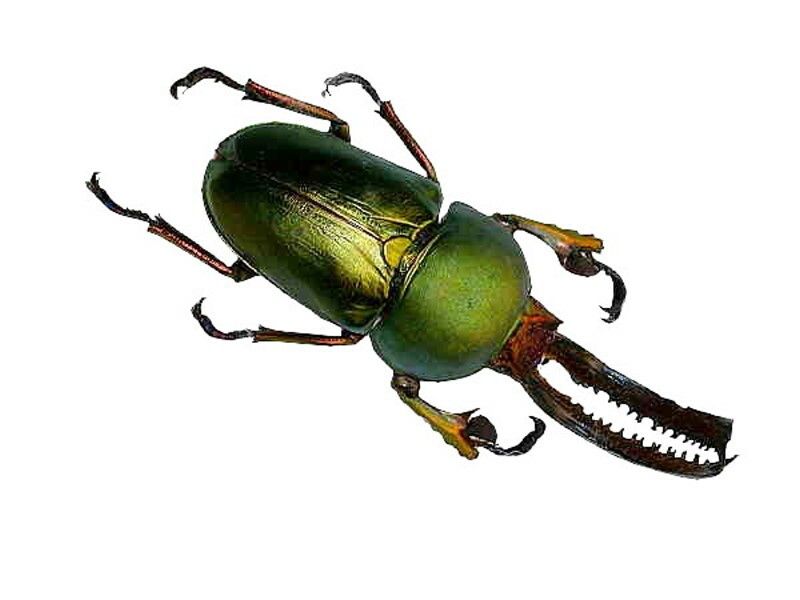
Here again, we have the problems photographically of a highly reflective surface which reveals parts of the body as distinctly green and others which have a golden cast. The head area and the “saw-like” process at the anterior end are reddish and present us with a remarkable contrast. These amazing structures are very likely used in territorial and mating contests between males to establish dominance. Such a battle would unquestionably present a distinctive spectacle.
Armor- and weapon-wise, one of the most impressive of all the rhinoceros beetles is Eupatorus which looks as though it were carved out of walnut and the anterior weaponry appears to be constructed of ebony.

Surely a battle between 2 of these males, especially when magnified on a theater screen and projected in high-resolution 3D would present itself as a clash of Titans.
When you’re outside on a winter’s eve in sub-zero temperatures, strolling with a friend, you might both welcome the idea of a wee nip. Well, here’s a fellow that could give you a wee nip.

This is a stag beetle of which there are a large number of species. Here’s another one.

Returning to the rhinos, there is a quite splendid species called Torynorrhina. In spite of what those of you in the anti-bug lobby think, these are marvelous organisms whose habitats are being destroyed at such an outrageous rate that many species will disappear before scientists even have a change to identify, catalog and study them. We’ll begin with this species by taking a close-up look at the head which prompts me to think of it as a “shovel-nosed” beetle and here we get a very nice image of the eyes.

If you look closely, you can see tiny bristles extending out from below each eye.
This beetle is a classic example of the difficulty of photographing these creatures. I want to show you 2 images where the illumination sources were the same, but the angles were different thus producing very different results. In both cases, there was ambient room sunlight, incandescent light, and an 8 inch fluorescent ring light on a swiveling arm which allowed for a wide range of adjustment, and the built-in flash unit from the Nikon CoolPix 995 camera.

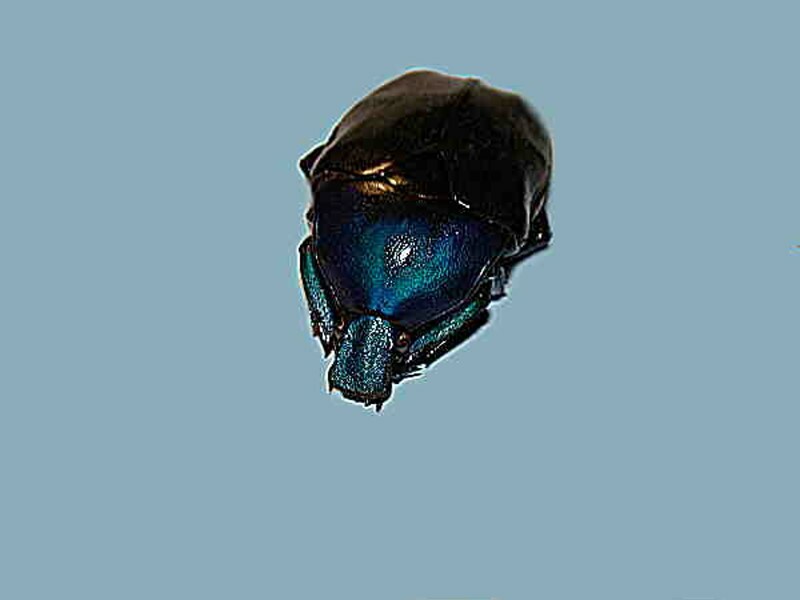
This second image is what I see when I look at this specimen under “normal” room light. So, the question arises: Is this rather dramatic difference between the 2 images simply an anomaly due to the shift in the angle of illumination or is there something else going on? I suspect that there is a very interesting something-else-going-on here which may well involve both structural morphology and pigmentation.
Another example can be found in the beetle Mouhotia where there is a distinct color shift along the top edge.


Our perception of color is an extraordinarily complex matter. In the prehistoric, ancient, and medieval worlds, color was a straightforward matter. You looked at an object and it was red or green (unless you were color-blind) or blue or yellow. However, Newton came along and got everything stirred up with his prisms and lenses. (These scientists are always troublemakers! Optics, relativity, evolution, climate change–why don’t they stay home and watch football on TV?)
Light is “composed of” photons which, I take it are colorless; there aren’t blue photons, pink photons, or mauve photons. Even if they did have color, what could we illuminate them with in order to test them for hue, tint, or shade? We are told that light has different wavelengths which constitute a spectrum, some of which we can see, some of which other animals can sense, and some of which we can detect with sophisticated technologies.
Here we encounter one of those wonderful conundrums of modern physics; Photons are light particles but they cluster and behave like waves, so here we observe that classic confrontation between particle theory and wave theory. I like Sir James Jeans’ solution best; he suggests that we stop fretting about the issue and simply call them “wavicles”
When we view an object, light is reflected or refracted or passes through it. When I look at a red cap on the whiskey bottle, is it “really” red? (I’d rather have the bottle in front of me than a frontal lobotomy.) The question is, of course, nonsense, because I can never get “outside” of my own consciousness, my own perception. I can’t remove or apply any special metaphysical glasses that would allow me to see things as they “really, truly” are. If my friend, Mike, insists that the red cap is green then, there are 3 major possible explanations: 1) he is color-blind, 2) he doesn’t know how to use color language, or 3) he is blind drunk.
Why is any of this important? Well, it leads to another very interesting level. Microscopists discovered early on that lenses need to be color-corrected in order to reduce distortion but, even more importantly, they discovered that some objects, like feathers, butterfly wings, and beetle elytra, have colors that are structural and colors that are a result of pigment. In other words, some of the colors which we see in feathers, butterfly wings, and beetle elytra aren’t the result of pigments inherent in those structures, but are rather a consequence of refraction and/or reflection due to the structural nature of those areas. The differences can be determined only by careful microscopical examination. Someone might object and ask if it isn’t true that “in the end” all color is a matter of structure and the answer is: well, yes and no; it is a matter of our level of discourse and explanation which is crucial for how we interpret and understand reality.
Consider the following case. Physicists tell us that a solid object such as the chair I am sitting on is 99% plus empty space. Now, I was sitting in chairs quite some time before I took any physics courses, so I don’t feel uneasy about sitting in chairs unless they are priceless antiques or on the verge of collapse; neither do I now subscribe to a delusion that I can walk through walls. My day-to-day experience supercedes any explanation from theoretical physics so, in an important sense, both kinds of explanation are reductively misleading and appear contradictory only if we ignore the conceptual frameworks out of which they arise. And so it is with color. In one sense, a physicalistic one, physical objects don’t have color. However, at the perceptual level, there is a fundamental foundation for distinguishing between pigments and structural colors. Of course, this too is an oversimplification and organism-dependent in a fascinating way. A large number of creatures have sensory apparatus that functions beyond the range of our sensory structures and these include color receptors.
In many organisms, the function of color is unclear as, for example, in numerous types of reef fish. Squids and octopi are master magicians when it comes to virtually instantaneous color transformations and research suggests that there are complex relationships between these changes and certain behavior patterns. Some biologists have even gone so far as to suggest correlations to emotions.
In beetles, we are not confronted with rapid transformations, but we do encounter a panoply of puzzles regarding the significance of specific colors in particular beetles and other insects. In some cases, both the color and the morphology of the insects function to provide a kind of camouflage . Two of the most striking examples are leaf insects and stick insects. First let’s look at a couple of leaf insects.


Different species have adapted in such a fashion that they mimic the leaves of a specific kind of plant. These adaptations are so successful that often one cannot see the insect in its natural environment until it moves and even then, one may sometimes wonder whether or not it is simply a light breeze causing the leaf to move. If during a storm, a leaf insect were dislodged and blown a considerable distance away, how would it “know” which kind of tree to seek refuge in again. Almost certainly, there are some complex biochemical interactions at work which involve highly sophisticated sensors in the insects.
The stick insects are even more bizarre and sometimes even more difficult to detect. This specimen is 11 inches long.

Mimicry occurs in moths, butterflies, and mantids as well, sometimes involving camouflage and other times not. The orchid mantids are an interesting case in which the insect does both and not only establishes a defense, but attracts prey as well. The plant world is full of predators as well and there are a significant number of insect-imitating orchids. I wonder if nature has gone so far as to produce an orchid-imitating insect of an insect-imitating orchid?
Batesian mimicry presents us with a fascinating example of the experimentation and tinkering of nature. There are a number of butterflies and moths that have developed chemical defenses against predators and they have distinctive wing patterns that send the signal to birds–“Stay Away! I taste terrible!” However, and this is the really intriguing part, over a long period of time, tasty species adapt in such a way as to have wing patterns that are similar enough to discourage many predators and thus the mimics increase their own survival rate. Here, of course, is where all the tinkering on nature’s part comes in, because there are far more extinct species (experiments that didn’t work out) than there are existing species. However, Big Mama Nature doesn’t play favorites, because there also evolve some birds that are oblivious to the bad taste and eat these insects anyway–perhaps it’s an acquired taste like humans develop for escargot, pate de fois gras, or tunicates.
Butterfly and moth scales are marvelous objects to study and in at least some instances are attached to the wing by tiny “loops”. Here are some scales
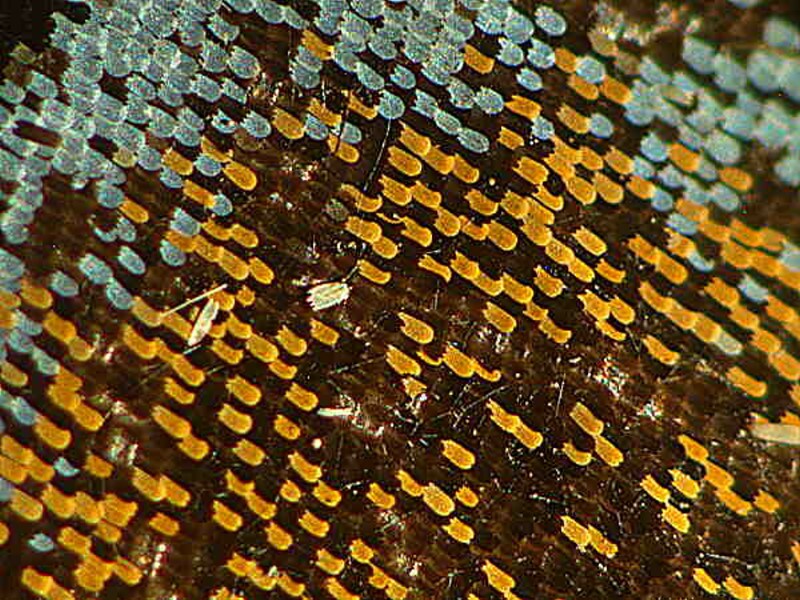
and here is an image showing the method of attachment.

Now, in case you’re getting impatient, this does have something to do with beetles because, you will remember our lovely blue weevil, Eupholus, also has scales. I haven’t yet figured out how they’re attached but, if I figure it out before I finish this essay I’ll let you know.
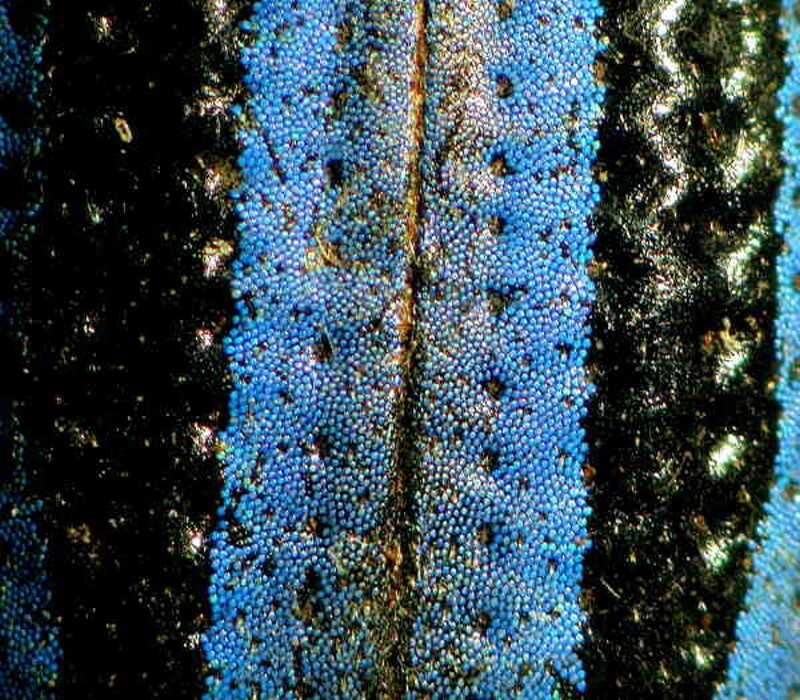
Just think, with all these lovely beetles we have dazzling pigments, refractive structural colors, scales, hairs, armor plating, claws, horn-like weaponry, pincers, and many other features that can provide us with many wonderful hours of investigation. What more can we ask for?
All comments to the author Richard Howey are welcomed.
Editor's note: Visit Richard Howey's new website at http://rhowey.googlepages.com/home where he plans to share aspects of his wide interests.
Microscopy UK Front
Page
Micscape
Magazine
Article
Library
Published in the June 2013 edition of Micscape Magazine.
Please report any Web problems or offer general comments to the Micscape Editor .
Micscape is the on-line monthly magazine of the Microscopy UK website at Microscopy-UK .
©
Onview.net Ltd, Microscopy-UK, and all contributors 1995
onwards. All rights reserved.
Main site is at
www.microscopy-uk.org.uk .